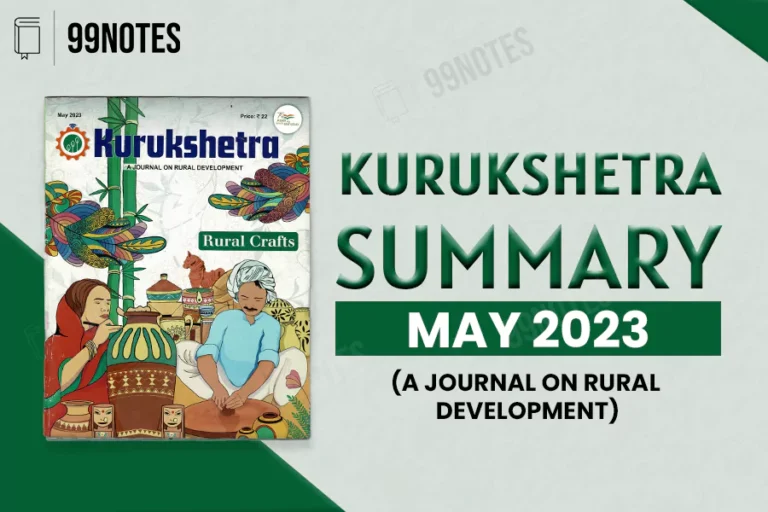June Kurukshetra – Water Conservation
During the Amrit Kaal, India is looking towards water as the future. June Kurukshetra addresses the issue of water conservation in this context.
Article 1: FOSTERING WATER MANAGEMENT FOR FOOD SECURITY
- Article 1: FOSTERING WATER MANAGEMENT FOR FOOD SECURITY
- ARTICLE 2: WATER CONSERVATION THROUGH COMMUNITY PLANNING
- ARTICLE: 3 EDUCATING PEOPLE TO SAVE EVERY DROP OF WATER
- ARTICLE 4: MAKING VILLAGES WATER SUFFICIENT
- ARTICLE: 5 WATER USE EFFICIENCY ENSURING WATER SUSTAINABILITY
- ARTICLE: 6 WATER CONSERVATION AMD MULTIPLE USE MANAGEMENT
Challenges of Water Scarcity:
- The increasing pressure on natural resources, specifically land and water, poses several challenges to the global food system and its sustainability.
- India has 18% of the world’s population and only 4% of its water resources.
- Water will be one of the most significant factors in India to ensure food security and achieve SDGs.
NEED FOR WATER CONSERVATION AND MANAGEMENT
With rising population, climate change, changes in land use, water cycle, Rainfall patterns, water management and conservation have become global priorities.
- Majority of Indian Districts Water Stressed: The availability of water per capita is less than a 1000-meter cube, which shows India as one of the most water-stressed countries in the world according to the NITI AYOG 2018.
- Increasing water demand: BY 2023, India’s water demand will be twice the available supply, affecting millions.
- Food Security: With the increasing population, agriculture will need to produce 50% more food, livestock fodder and biofuel than in 2012 to fulfil global demand and keep on track to achieve ZERO HUNGER (FAO, 2021)
To address the projected demand and supply gap, our policymakers are working to shift farming from intensive to resource-efficient climate-smart agriculture.
Water conservation strategies in agriculture:
Pradhan Mantri Krishi sinchayee Yojana (PMKSY)
- The PMKSY launched 2015-2016 with a strong vision of 100% irrigation coverage through the ‘HAR KHET KO PANNI’ campaign and to improve water use efficiency, i.e., ‘PER DROP MORE CROP’.
- The scheme provided an end-to-end irrigation solution through source creation, distribution, management, field application, and extensive activities.
PER DROP MORE CROP:
- It is a component of PMKSY, which focuses on enhancing water use efficiency, productivity, and reduction in input costs through Micro irrigation.
- This scheme was launched in 2015-2016, i.e., drip and sprinkler irrigation system. Under this, the government provides financial assistance or subsidies to small and marginal farmers.
- The irrigation efficiency under microirrigation is 80-90 %. A Micro irrigation fund with an initial corpus of rupee 5000 crores was created with the help of NABARD to facilitate the states in mobilizing the resources for expanding micro irrigation. In the Union budget 2021-2022, this corpus was increased to RS. 1000 crores.
SAHI FASAL CAMPAIGN:
This campaign is a component of the national water mission initiated by the Ministry of Jal Sakti, which aims to raise awareness amongst the farming community on water-efficient farming.
BHARTIYA PRAKRATIK KRISHI PADDHATI:
- This scheme is for promoting natural farming.
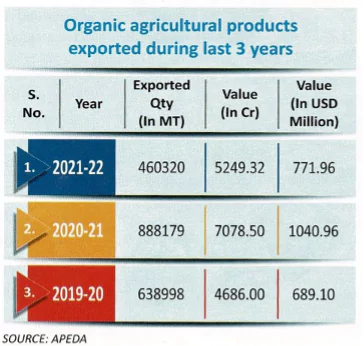
- The aim is to minimize the cost of cultivation, enhance farmers’ income, and ensure environmental sustainability.
- Natural farming is a resource-efficient agroecological-based farming practice.
- The economic survey (2021-2022) showed that increased paddy cultivation in 44 million hectares resulted in over-exploiting groundwater resources.
- Efforts were made by the Ministry of Agriculture and Farmers Welfare (MoA & FW) in promoting states to diversify agricultural/horticultural crops through various ongoing schemes like – the National Food Security Mission (NFSM), RAINWATER CONSERVATION:

- The green revolution will occur in rainfed agriculture, which warrants its rapid growth, efficient management, and sustainability.
- Rainwater harvesting, conservation and its efficient utilization through multiple-use management play a crucial role in rainfed agriculture and are being taken up on a massive scale through various government schemes.
- Rainwater harvesting may be defined as collecting and storing rainwater at the surface or in a subsurface aquifer before it is lost as surface runoff.
- Rashtriya Krishi Vikas Yojana (RKVY), Mission for integrated development of Horticulture (MIDH), National Mission for sustainable agriculture (NMSA), etc.
WAY FORWARD:
Water is a state subject and requires cooperation to harness steps for conserving and efficiently managing water resources across states. India is an agricultural economy, and food security and natural resource conservation are needed to guide land and water allocation to ensure sustainable agriculture and the nation’s socioeconomic development.
ARTICLE 2: WATER CONSERVATION THROUGH COMMUNITY PLANNING
The community and the end beneficiaries should be engaged in various stages of the water conservation program implementation – from identifying the need to prioritize conservation activities, performance, and community monitoring of water-related works.
To achieve the objectives of inclusive growth with equity and social justice, the overall development of basic infrastructure is a must. An important component is to arrange an adequate, timely, and affordable water supply for becoming a water–secure nation and ensuring a healthy and economically productive society.
COMMUNITY PARTICIPATION IN WATER CONSERVATION
As per the constitution of India, Water is a state subject. The respective states are responsible for conserving and managing the water.
- Water conservation efforts are supported through various central government schemes with required technical and financial assistance provisions.
- Civil participation in the management processes of any public development endeavour results in better outcomes.
WATER CONSERVATION BY PROGRAMMES IMPLEMENTED BY STATES
1. Neeru – chettu
- The implementing state is Andhra Pradesh.
- The aim is collective participation and to spread awareness to make the state ‘drought-proof’ through better water conservation.
- The activity involves Rejuvenating and revitalizing natural resources. De–silting of tanks and feeder channels, etc.,
2. Jal Jeevan Nariyal
- The objective is to encourage farmers to participate in the government’s water conservation initiatives and sensitize them to use alternative crops, organic farming, drip irrigation and other technologies with less dependence on irrigation.
- It involves identifying, restoring, and renovating all public water storage structures –ponds/canals/pines, etc.333
3. Sujalam sufalam jal sanchay abhiyan
- Implementing state in Gujrat
- It is a public-private partnership programme, and the government contributes 60% of the work expenditure.
- The programme involves deepening water bodies in the state before the monsoon arrives to increase rainwater storage for use during times of scarcity.
4. Jal hi jeevan hai
- The implementing state is Haryana.
- It encourages farmers to adopt crop diversification and sow crops requiring less water, like Maize, Arhar, etc. Instead of water-guzzling crops such as paddy to conserve water.
5. Pani Panchayat
- The implementing state is Haryana.
- It aims to ensure the optimum utilization of water and improve agricultural production.
6. Jalyukt shivar Abhiyan
- Implementing State: Maharashtra
- It aims to make Maharashtra drought-free by creating 5,000 villages free of water scarcity each year.
Water conservation initiatives of the Union government
India has irrigation of 141 million hectares of net shown area, out of which about 65 million hectares are currently covered under irrigation of any source.
- Pradhan mantra Krishi sinchayee yojana aims to ensure sustainable access to some means of irrigation to all agriculture farms in the country.
- The various component of PMKSY that need adequate community planning and participation during the implementation phase is-
- Har khet ko pani.
- Watershed development.
- Per drop more crop.
- MGNERGA
MEASURES FOR THE SUCCESS OF WATER CONSERVATION EFFORTS
The 73rd Constitutional Amendment empowers gram panchayats to plan and manage rural water supply and sanitation systems.
- Preparation of water security plan, irrigation plan and village action plan.
- Discuss and deliberate on the sustainability of water schemes and explore new revenue sources for water conservation systems.
- Promoting timely execution of projects and utilization of funds.
- Arrange training and capacity-building programmes on water collection, storage, usage, etc., for grassroots workers.
CONCLUSION
The water conservation programmes would successfully achieve their objectives only if the community and beneficiaries are involved in various stages of programme implementation.
ARTICLE: 3 EDUCATING PEOPLE TO SAVE EVERY DROP OF WATER
INTRODUCTION
In response to the global water crisis, the United Nations has established a sustainable development goal: ensuring everyone has access to water and sanitation. The main objective is to attain universal access to safe, affordable drinking water that is equitable for all by 2030. Water is a growing challenge as India has 18 % of the world’s population and only 4% of global water resources.
- Despite having abundant rainfall, India faces frequent droughts, floods and water scarcity due to inadequate water management practices and rapid urbanization.
- Tackling the water crisis requires a concerted effort from various stakeholders, including government, civic bodies, administration, educational institutions, NGOs, media, and society.
NATIONAL WATER MISSION
The National Water Mission is one of the 8 missions under the national climate change action plan.
- Its main objective is the ‘conservation of water, minimizing wastage, and ensuring its more equitable distribution both across and within states through integrated water resources development and management ‘.
- One of the five goals of the NWM is to promote citizen and state actions for water conservation, augmentation, and preservation.
- One of the strategies of NWM is to incentivize the organization or companies through awards for water conservation and efficient water use. Its annual NWM water awards recognize excellence in water conservation, water-use efficiency, and sustainable water management practices.
- Water Talk – The NWM organized a lecture series called ‘Water Talk’ to facilitate the exchange of information about water–related topics. The water talk takes place on the third Friday of every month and features presentations from experts and practitioners.
CATCH THE RAIN CAMPAIGN
- The ‘Catch the Rain’ campaign uses the slogan ‘Catch the rain, where it falls when it falls “, which is nothing but an expression of the desire to collect, save, and manage every drop of water.
- It is part of the government’s strategy to address the issue of water scarcity at its roots. It encourages states and stakeholders to build appropriate rainwater harvesting structures based on the local climatic conditions and sub-soil strata before the monsoon season.
STRATEGIES TO EDUCATE PEOPLE
Through education and awareness–building campaigns, individuals can be empowered to take responsibility for their water consumption and ensure that every drop of this precious resource is conserved. Many mass awareness campaigns were launched on water conservation, like street theatres, jal yantras, puppet shows, and media campaigns.
Doordarshan Akashwani and other government media platforms have continuously created mass awareness. While continuing such good practices, the union and state governments can explore measures such as:
- SOCIAL MEDIA – to reach out to the people directly in real–time and proactively engage with them.
- CONVENTIONAL MEDIA –using mediums like TV, newspapers, and radio as these have vast footprints across the country.
- ENGAGING COMMUNITIES – organizing community programmes like seminars, workshops, etc.
- INCENTIVES AND REWARDS – incentives like tax rebates and discounts can be offered to encourage people to conserve water. This can be done locally with support from the centre or state governments.
- INVOLVING PRIVATE SECTOR – There are already some private organizations that are running campaigns for the conservation of water.
- ENGAGING WITH EMINENT PERSONALITIES – Celebrity involvement can be sought to attract public attention and promote water conservation initiatives.
ARTICLE 4: MAKING VILLAGES WATER SUFFICIENT
The availability of sufficient water for the growing population will be one of the crucial challenges for human development across the globe.
“Climate–driven food and water insecurity is expected to increase with increased warming.” – IPCC, March 2023.
Localization of SDGs –
Localizing sustainable development goals through PRIs is a plan towards achieving sustainable development goals.
The 17 UN –SDGs have been remapped into 9 broad themes –
- Theme 1 – poverty-free and enhanced livelihood villages.
- Theme 2 – Healthy town.
- Theme 3 – Child-friendly village.
- Theme 4 – Water sufficient town.
- Theme 5 – Clean and green village.
- Theme 6 – Self-sufficient infrastructure in the village.
- Theme 7 – Socially secured village.
- Theme 8 – Village with good governance.
- Theme 9 – Engendered Development in the Village.
The Ministry of Panchayat Raj (MoPR) has brought SDGs into PRIs (Panchayati Raj Institutions). The GOI has approved Rs 5911 cr. under the revamped Rashtriya Gram Swaraj Yojana (RGSY), which is aimed at empowering 2,78,000 Panchayati Raj Institutions (PRIs) to implement a set of social goals that the United Nations has deemed necessary for sustainable development.
Water Sufficient Village
Theme 4 of the LSDGs- Water Sufficient Village is related to many other SDGs. For example, lack of adequate water for irrigation leads to low income for marginal farmers and landless labourers dependent on agriculture, and their livelihood will likely fall below the poverty line (SDG 1- Poverty); adequate water irrigation will increase agricultural productivity (SDG 2- Zero Hunger) and so on.
Theme 4 – Water Sufficient Village is multi-dimensional and directly related to health, education, gender equality, sustainable and efficient use of natural resources, etc.
- Under Theme 4, 9 sub-goals have been set with 25 Modified GP (Gram Panchayat) Level Indicators to assess, analyze and monitor the progress.
- Providing access to clean water to all village households by 2024.
- Provide access to sanitation in the villages.
- Achieve ODF (Open Defecation Free) sustainability.
- Grey water management.
- Per capita availability of water in villages.
- Construction of rainwater harvesting and recharge works.
- Safeguarding of water bodies.
- Constitution of Village Water and Sanitation Committees (VWSCs) in each Gram Panchayat.
- Water efficient agricultural practices.
Learning from the Good Initiatives and Practices –
Many results-yielding initiatives are in operation in different parts of the country for the restoration, conservation and sustainable use of water resources. Such initiatives must be documented, and attempts should be made to replicate with any necessary customization.
Kerala is the first state in the country to prepare a Water Budget based on local self-government bodies by calculating water availability and consumption. The water budget puts forward scientific methods for conserving water resources and aims to create public awareness about the need for water conservation.
In Telangana state, the Mission Bhagiratha scheme is implemented in all the villages to provide safe and sustainable drinking water to all households. Also, the Mission Kakatiya scheme was implemented to restore the irrigation tanks to their full capacity. Several water conservations work, like the construction of check demand, other harvesting structures, desilting of feeder and field channels, etc., are taken up under MGNREGA.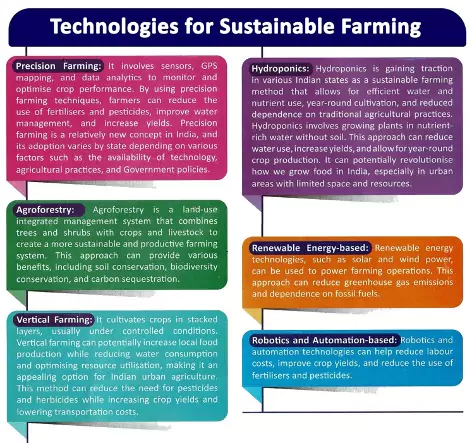
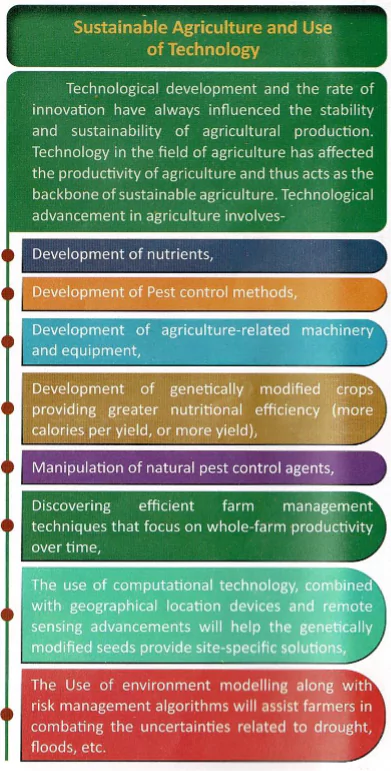
CONCLUSION:
A local institution such as a panchayat has a crucial role in achieving a water-sufficient village. Further, the gram panchayat development plan will mainstream all water-related issues. The participation of people, community–led management, training and capacity building of PR functionaries and officials of various line departments will bring the desired results regarding water–sufficient villages.
ARTICLE: 5 WATER USE EFFICIENCY ENSURING WATER SUSTAINABILITY
INTRODUCTION
Water is the lifeblood of the ecosystem, vital to human health and well-being, and a precondition for economic prosperity. Water is at the very core of the 2030 agenda for sustainable development.
Sustainable development goals – Target 6.4 addresses water use efficiency and water stress. It aims to substantially increase water use efficiency by 2030 across all sectors and further aims to ensure sustainable withdrawals(sewage) and supply of freshwater to address water scarcity. This will substantially reduce the number of people suffering from water scarcity.
Water Use Efficiency-
Water Use Efficiency is the ratio between effective water use and actual water withdrawal.
Enhancing water use efficiency in every sector of water use (agriculture, drinking, domestic, etc.) is vital for sustaining life faced with the challenges posed by climate change in the water sector.
Water Use Efficiency in Agriculture
India is an agricultural country where most of the population depends on Agriculture.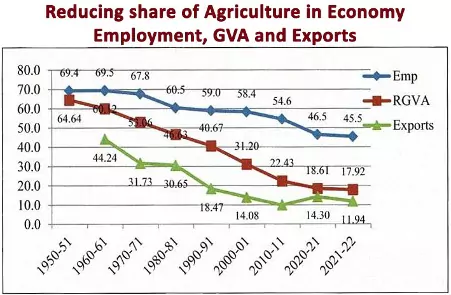
- Water Use Efficiency (WUE) in irrigation is the percentage of the irrigation water consumed by an irrigated farm, field and project crop to the water delivered from the source. Some water is lost due to conveyance, distribution and application in the area.
- In India, the agriculture sector is the largest consumer of water resources. Therefore, even a small percentage saving of water in this sector will have a large impact on the availability of water for drinking and domestic purposes.
Methods for Improving Water Use Efficiency in Agriculture –
1. Micro Irrigation –
The WUE in micro-irrigation, including drip irrigation, is as high as 80-95% compared to only 30-50% in conventional flood irrigation. The micro-irrigation techniques also help reduce waterlogging, fertilizer usage, labour expenses and other input costs and enhance agricultural productivity and farmers’ income besides sustaining soil health.
2. Mulching –
- Mulching helps increase WUE by controlling water losses by evaporation from the plant root zone.
- A mulch is a material spread on the top of the soil – plastic sheets, organic material.
- There is about 10% water saving from using mulch materials in agriculture.
3. Drought- Tolerant Crops –
- Growing crops appropriate to the region’s climate also helps get more crops per drop.
- The ICAR has developed several drought-tolerant short-duration crop varieties that suit different agro-climatic regions of the country for judicious use of water.
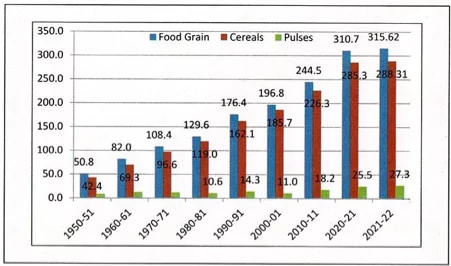
Water Use Efficiency (WUE) in Industrial Sector –
Recent studies have revealed that industrial water demand will quadruple between 2005 and 2030, putting further pressure on the already over-allocated water resources of the country.
The water scarcity has led to the shutting down of at least India’s 20 largest thermal utilities between 2013 & 2016, taking a total financial toll of USD 1.4 billion. Therefore, companies need to elevate water resource management beyond corporate social responsibilities.
Initiatives to increase WUE in the Industrial Sector –
- The National Water Mission has awarded a benchmarking study to TERIregarding ‘Benchmarking Industrial Water Use to Assist Policy for Enhancing Industrial WUE in India’.
- In phase 1, the study would focus on two industrial sectors – thermal power plants and textile industries.
- In phase 2, water audits in pulp, paper, and steel industries would be taken up.
Initiatives to increase WUE in the domestic sector –
- The National Water Mission has recommended that BIS issue standards for water-efficient plumbing products.
- AMRUT Mission- It aims at sustainable management of water in urban areas
ARTICLE: 6 WATER CONSERVATION AMD MULTIPLE USE MANAGEMENT
INTRODUCTION
Water is the most essential natural resource for
the Mankind. However, the increased climate variability has erased rainfall patterns that warrant water resources development, conservation and multiple-use management, especially in the agriculture sector, which is the dominant consumer of water (about 70 per cent).
WATER AVAILABILITY
Hydro-meteorological and geological factors heavily influence a country’s average yearly water availability. Due to geological and other causes, the available usable water is limited to 1,128 BCM per year, which includes 690 BCM of surface water and 438 BCM of replenishable groundwater.
WATER FOR AGRICULTURE:
- Agriculture is the biggest water user, accounting for over 70% of water withdrawals worldwide.
- Gross water demand for all users in India is expected to grow from 750 BCM in 2000 to 1027 BCM by 2025.
- Water as a source of irrigation has emerged as the mainstay of the agricultural economy.
RAINWATER CONSERVATION:
- The green revolution will occur in rainfed agriculture, which warrants its rapid growth, efficient management, and sustainability.
- Rainwater harvesting, conservation and its efficient utilization through multiple-use management play a crucial role in rainfed agriculture and are being taken up on a massive scale through various government schemes.
- Rainwater harvesting may be defined as collecting and storing rainwater at the surface or in a subsurface aquifer before it is lost as surface runoff.
WAY FORWARD:
The main objective of the national water mission is the conservation of water, minimizing wastage and ensuring its more equitable distribution both across and within states through integrated water resources development and management. The message of water conservation and multiple uses Management needs to be communicated across all levels; creating awareness and an enabling environment for water conservation at various levels through information, education, and Communication is an important activity to face the challenges of water scarcity.


